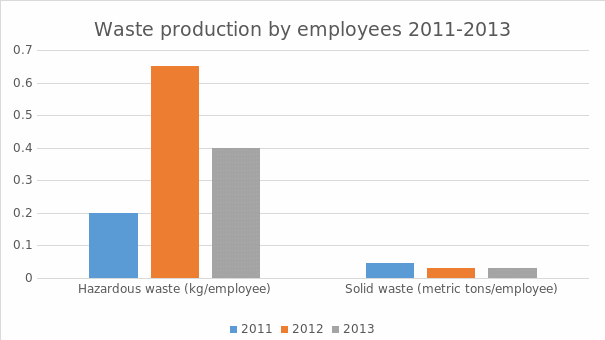Introduction
A 2010 survey for CEOs discovered that the overwhelming majority (96%) of them reckon sustainability as a priority for any establishment (Heizer and Render 2014). Indeed, nowadays, companies neglecting sustainability issues might eventually come to face financial ones (Iarossi 2013). This paper is going to assess the sustainability strategies that Apple, Inc. deploys and enlist possible points for improvement.
Apple, Inc.: Background
Apple, Inc. (Apple) is a software and electronic devices corporation formed in 1976 in California. The unflagging demand for the company’s products and the high sales rate can indicate the quality of the products is more than satisfactory. Besides, Apple products are considered prestigious. In terms of sustainability, Apple has developed some strategies, which might be yet another explanation of its popularity.
Advantages of Apple’s sustainability policies
As to the economic sustainability, several practices can be singled out. First and foremost, apart from helping the environment, Apple goes green as a means of meeting the consumers’ demand for sustainable production. In social terms, Apple has deployed the Supplier Code where the rules of production and transportation are enlisted. Within the Supplier Code, which is an adaptation of the Electronics Industry Code, the company ensures the suppliers’ employees are informed of their rights and enabled to exercise them (Environmental Responsibility Report 2014).
Currently, the public demand is focused on environment-friendly goods and sustainable policies of their production and transportation. The products themselves and their packages consist of recyclable materials, and the manufacturing cuts back on toxic offenders such as PVC, mercury, lead, and arsenic (Environmental Responsibility 2016). The energy usage cutback is also visible. Newer Apple products belonging to iPhone and iPad lines are even less energy-consuming than their predecessors. For example, a new-generation iPad is twice as powerful as the preceding ones, while at the same time sustaining a ten-hour energy accumulator (iPad Pro: Thin. Light. Epic. 2016).
By reducing its greenhouse gas emissions, as well as deploying the energy collected from natural resources, the company is aimed at eliminating their negative impact on the environment whatsoever. The company regards corporate self-regulation (CRS) as an indispensable part of its business model (Environmental Responsibility Report 2014). Finite resources usage and waste production are taken under control.
As one can see from the diagram below, the company has acknowledged hazardous waste production issues and decreased the amount of such waste produced by the employees from 0.65 kilograms in 2012 to 0.4 kilograms by 2013. The overall amount of solid waste produced annually by employees has been kept at a stable level of 0.03 metric tons in the years 2012 and 2013.

Drawbacks of Apple’s sustainability policies
At the first gaze, Apple’s policy might seem flawless due to the company’s well-designed image. But, albeit its success that might seem a marvel for some and a curse for others, some minor and major drawbacks in Apple’s sustainability can be traced even by an unaided eye. For instance, the honorific attributed to the company in 2012 was king of promoters (Elmer-DeWitt 2012).
That said, one might as well wonder whether the company’s business practices are truly aimed at sustainability or revenue, and whether its investment in sustainability is overpowered by those practices. An important point to consider here is that Apple’s reports on whether it has fulfilled its sustainability plans remain undisclosed. Also, the Code for suppliers that Apple has established has some points of controversy.
Sustainability in business subsumes not only the utilization of green raw materials and reducing environmental damage but also treating the workers fairly. Some of Apple’s suppliers – e.g., Foxconn – are believed to be breaching that last part of sustainable operation in terms of corporate ethics and adequate man-work interface (Mattews 2013). In addition, the company’s production facilities are quite far from its sales points.
Which is why monitoring and maintenance of practices in all facilities appears rather complicated (Mattews 2013). It is known that some of the Apple’s facilities are located in China and Korea where sustainability is not considered an ultimate priority. Thus, the company fails to build an adequate supply chain as well (Elmer-DeWitt 2012; Christopher 2011).
Recommendations
Having experienced a conflict with hazardous waste production, the company has adjusted its CRS policies; it has also cut back on polyvinyl chloride ad other toxins. Consequently, the environmental aspect of sustainability is fulfilled. On the social side, however, the company fails to recognize the suppliers’ abuse of human rights, which does not comply with social sustainability goals it had set. One can recommend that the company disclose its supply chain policies and apply stricter standards to the social responsibility of its suppliers.
Conclusion
To conclude, sustainability has become a point of concern for major global organizations, including Apple. So far, the company has undertaken some successful steps to promote sustainability. Nevertheless, the company is yet to build an adequate supply chain and successfully monitor whether their production houses are sustainability-oriented. So as to create a sustainable business, the organizations should pay their full attention to the ideas and the ways of implementing them; Apple has not proved itself to be fully sustainable, at that.
References
Christopher, M 2011, Logistics and Supply Chain Management, 4th edn, Prentice Hall, Upper Saddle River, NJ.
Elmer-DeWitt, P 2012, Perception vs. reality: Apple’s sustainability gap. Web.
Environmental Responsibility 2016. Web.
Environmental Responsibility: Toxins 2016. Web.
Environmental Responsibility Report: 2014 Progress Report, Covering FY2013 2014. Web.
Heizer, JH, & Render, B 2014, Operations management: sustainability and supply chain management, Pearson Education Limited, Harlow, UK.
Iarossi, J 2013, ‘Addressing the Sustainability Challenge: Insights from Institutional Theory and Organizational Learning’, Journal of Leadership, Accountability & Ethics, vol. 10, no. 1, pp. 76-91.
iPad Pro: Thin. Light. Epic. 2016. Web.
Mattews, R 2013, Is Apple’s Adoption of Sustainability Too Little Too Late? Web.